 |
 |
 |
 |
 |
 |
 |
| Ghettos |
The Bialystok district, of which Grodno became part, experienced a turbulent history. As a border region between Poles, Lithuanians, Russians and Ukrainians, it was often subject to military attack. In 1939, it was conquered by German troops. These troops later withdrew and the region was occupied by the Soviet Union, only for German troops to reoccupy it immediately following the commencement of hostilities between Germany and the Soviet Union in June 1941. On the night of 22-23 June 1941 the city fell to the German army. At first Grodno was not included in the Bialystok district but remained part of the Generalkommissariat Weissrussland. Then, on 18 September 1941, it was attached to the Bialystok district.
A Gestapo deputy office (Nebenstelle) was set up in Grodno, initially headed by Kriminalsekretär Gross, and, from December 1941, by Heinz Errelis. Errelis had thirteen men under his command, including his deputy, Schott. Gross, who was in charge of Jewish affairs; Kurt Wiese, who would afterward become the commandant of Ghetto I; Otto Strebelow, commandant of Ghetto II and Karl Rinzler, commandant of the Kielbasin concentration camp.
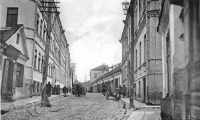 |
| Ghetto Street #1 |
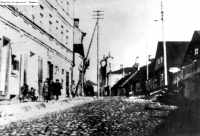 |
| Ghetto Street #2 |
 |
| Arrival at the Ghetto #1 |
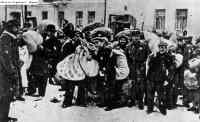 |
| Arrival at the Ghetto #2 |
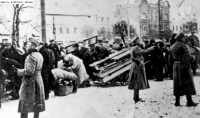 |
| Batory Square |
The occupants of the Grodno ghetto, like their brethren in many other ghettos across Poland, adopted the slogan, "salvation through work". In other words, nearly everyone believed that as long as the Germans considered the ghetto occupants to be productive elements who were useful to their economy, they would let them live. Factories were therefore created to produce items for the German war economy and to supply the personal needs of army and Gestapo personnel stationed in Grodno.
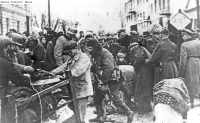 |
| Arrival from Rzeszow |
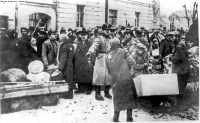 |
| Arrival from Suchowola |
In late 1942, exactly one year after Grodno’s Jews had been herded into the ghettos, the Germans began making preparations for transporting them to the death camps. In the winter of 1942/1943, when the transports ceased elsewhere in Poland (in the Generalgouvernement and in the Warthegau), it was the turn of the Jews in the Bialystok district. There were about 130,000 Jews in 116 localities, including 35,000 in nineteen locales in the Grodno sub district. The officials responsible for the transports in the Grodno sub district were Heinz Errelis, the chief of the Gestapo in the city, and his deputy, Erich Schott. Transit camps, or as the Germans called them Sammellager, which were actually stations on the way to deportation to the death camps, were set up at various sites in the Bialystok district. The sites of the transit camps were chosen for their proximity to Jewish places of residence. In the case of Grodno, a transit camp was set up at Kielbasin (Kelbasino). From the transit camps the Jews were transported to Auschwitz and Treblinka. Jews from the Bielsk-Podloski sub district, in the southern part of the district, were sent directly to nearby Treblinka without passing through a transit camp. The horrific conditions in the transit camps - overcrowding, inhuman living quarters, nonexistent sanitation, serious food shortages, bitter cold, and unspeakable filth - inevitably led to illness and epidemics. The mortality rate was high. Inmates were also subjected to all manners of harassments, beatings, abuse, and even outright murder by the staff and guards.
On 2 November 1942, the Ghettos I and II in Grodno were completely sealed off. In the morning the workers from Ghetto II were held up at the gate and suddenly the commandants of the two ghettos, Kurt Wiese (Ghetto I) and Otto Strebelow (Ghetto II), appeared and began shooting at the workers indiscriminately. 12 Jews were killed, forty were wounded, and the others fled wildly in panic. It was the first time that Grodno’s Jews had experienced sudden mass murder, perpetrated without warning. In the evening, the news spread through the city that the Jews from the neighbouring towns had been transported to the Kielbasin camp. The sealing of the two ghettos was accompanied by show-hangings and acts of group murder. Punitive executions were not only meted out for trying to escape. The fate of anyone caught smuggling food into the ghetto was also sealed. Shooting of Jews who were found carrying bread or other food became routine.
About two weeks after the Jews in the neighbouring towns were taken to Kielbasin, the Germans began liquidating Ghetto II. First, however, they transferred those with useful professions from Ghetto II to Ghetto I. The first deportation from Ghetto II took place on 15 November 1942. The Jews were told that they were being sent to work, and, according to the testimony of Grodno survivors who reached Bialystok in 1943, the Judenrat and the other Jews in the ghetto believed this tale. Therefore, very few tried to hide. The deportees reached Auschwitz on 18 November, and before they were murdered they were given prepared postcards on which a sentence in German was printed: "Being treated well, we are working and everything is fine". They were ordered to sign the postcards and address them to their relatives in Grodno. The first deportation was followed by a brief lull in Ghetto II. But a few days later, on 21 November, everyone still in the ghetto was deported to Auschwitz. There is some uncertainty regarding the precise number of deportees, but it is probable that at least 4,000 inhabitants of the ghetto - those remaining in Ghetto II after the transfer of a similar number of Jews to Ghetto I - perished in Auschwitz as a result of these "actions".
The deportations from Ghetto I began at the end of November 1942, following the opening of the Kielbasin transit camp; they followed a different pattern from previous "actions" in the region’s ghettos and in Ghetto II at Grodno. All told, about 4,000 Jews from Ghetto I were sent to Kielbasin in two transports. Later they were deported from Kielbasin to Auschwitz and Treblinka.
The first Aktion in Ghetto I (the third in Grodno) took place in late November 1942. In the dead of night, men, women, and children were removed from their apartments and concentrated in the Great Synagogue. Toward morning Wiese and Strebelow arrived, ordered the Jews out of the synagogue, and began to march them to Kielbasin, all the while beating them. At the front of the column marched a respected Jew, Skibelski. The Germans forced him to wear a clown’s hat, dance and play the fiddle.
Kielbasin, formerly the farm of a Polish squire, lay 5 km from Grodno, on the road to Kuznica. The Germans converted it into a camp for Soviet POWs. The camp covered 1 square km, and a double barbed-wire fence surrounded it, with a guard tower at every corner. By the autumn of 1942, there were no further POWs in the camp. It then became a concentration camp for Jews from Grodno and from the surrounding towns. It has been estimated that at least 35,000 men, women and children were deported to Kielbasin from Grodno and the surrounding area. Survivors of Kielbasin remember its commandant, a Rumanian-born German named Karl Rinzler who could speak Yiddish mixed with German, for his extraordinary brutality. Almost always inebriated, he would take inmates from their huts and shoot them publicly for his amusement. In the morning, upon entering the camp, he called over every Jew he encountered (especially women) and with a heavy rubber club that had a small metal ball attached to its end, beat them until the club was drenched in blood.
The Kielbasin inmates lived in a sort of barracks, "Ziemlankas", as the camp’s inhabitants called them, 50-100 m long, 6-8 m wide, and about 2 m high (the floor was half a meter deep under the ground). They were the products of the Soviet prisoners' labour during the camp’s previous incarnation. There were six blocks of these barracks, which were separated from one another by barbed-wire fences. A block consisted of fourteen barracks, each of which held at least 250 or 300 inmates (about 500, according to Errelis). Towns populated these barracks: each town was allotted one or more barracks on the basis of its Jewish population.
The floor in these Ziemlankas was plain earth padded at the bottom with branches and covered with straw. On entering one had to step down five or six steps. Inside there were double shelves/bunks, which served for sleeping. Those in the bottom row could sit but not stand up. Those on top had the roof immediately above them and had to crawl in order to lie down. The boards were dirty, and water leaked in from the roof. Men, women, and children lived together in each Ziemlanka, and also shared the toilet - an open pit, for men and women together. The overcrowding, the bitter cold, the rain that leaked in, and the filth and lice turned these accommodations into death traps. The camp had running water, but Jews were forbidden to go near the taps. It was not uncommon for inmates to be flogged to death for stealing water. Hunger was a permanent fixture at Kielbasin. Food rations consisted of soup with a few unpeeled potatoes or scraps of rotten cauliflower cooked in water and 100-150 grams of bread per person - though even that miserly bread portion was not distributed every day. The hunger, overcrowding, dirt, and lice resulted in lethal epidemics that claimed many victims - seventy a day, on the average. The ill were transferred to separate Ziemlankas and treated by Jewish physicians and nurses who were also incarcerated at Kielbasin.
But Kielbasin was only a transit camp. A week after the first Jews were imprisoned there, the transports to Auschwitz began. The order to begin the transports was issued by the Reich Main Security Office (RSHA) to Wilhelm Altenloh, head of the Gestapo in the Bialystok district, who relayed it, first by telephone and then in writing, to Errelis and to the Gestapo’s external station at Grodno. The police and personnel of Sipo and the SD read out the names of the towns; their former inhabitants were then concentrated in the centre of the camp and made to march to the train station at Lososna. The elderly and infirm that were unable to keep up with the march were shot on the spot. At the station the Jews were packed into freight cars for their final journey. In December 1942, a severe shortage of railway wagons forced the Germans to suspend temporarily transports to Auschwitz from the Bialystok district ghettos and from Kielbasin. Instead, however, they stepped up the transports to Treblinka, which was relatively close. Towards the end of the month, the Germans decided to liquidate the camp. The last of the Jews there, 2,000-3,000, from Druskieniki, Suchowola, and Grodno (as well as those who had avoided the earlier transports by hiding) were made to walk back to Ghetto I in Grodno. Again a Jew playing a fiddle was placed at the head of the column. Some Kielbasin inmates had managed to escape from the camp during its brief existence.
The respite in the deportations from the Bialystok district lasted about a month, from mid-December 1942 until mid-January 1943. But on 18 January 1943, deportation notices began to be issued. That evening the ghetto’s gates were sealed for five days (until 22 January), and the Jews were not allowed out. The manhunt began. More than 10,000 people were rounded up and herded into the Great Synagogue. The deportees were marched to the train station at Lososna; only the elderly, the sick, and the children were transported there by wagon or truck. Guards were present in large numbers, shooting those who could not keep up. At the train station the deportees were shoved and pushed on top of each other into cattle cars; the doors were closed and sealed; and they set off on their final journey. During the January 1943 Aktion, 11,650 Jews were deported from Grodno to Auschwitz-Birkenau. Of these, 9,851 were murdered as soon as they arrived at the extermination camp, while 1,799 (1,096 men and 703 women) were selected for forced labour.
Following the "Action of the Ten Thousand", approximately 5,000 Jews remained in the ghetto, about half of them "illegals" without papers. On 11 February 1943, the Judenrat announced that the Jews were being sent "to new places of work". Two days later, on 13 February, a few hundred Jews were taken to work outside the ghetto. Shortly after their departure, the ghetto was closed and a new Aktion commenced. Wiese, Strebelow, and their cohorts appeared at the ghetto gates, where hundreds of Jews were assembled in the hope that they would be taken to work. Shooting into the crowd began. The Jews were then made to line up and marched to the synagogue. Some managed to flee, others were shot in the attempt. The members of the Judenrat and its clerks, led by Brawer, were also herded into the synagogue. At around dusk Brawer was called outside, where Wiese shot him after discovering that two "Farbindungsmen" (liaison-men) of the Judenrat, had fled from the ghetto.
A few youngsters tried to break down the doors and windows in the synagogue and escape. Some Jews hid inside the synagogue itself. At 10 p.m. the manhunt was called off, and during the night the detainees were made to march to the Lososna train station. On the way there were more escape attempts. Some were shot to death, but a few dozen did succeed in getting away. The transport left Lososna at 5:40 a.m. and reached Treblinka at ten minutes past noon. Two days later the manhunt resumed.
On the final day of the Aktion, on 16 February 1943, Jewish policemen went through the streets announcing that anyone caught outside would be shot, but that no harm would come to those who assembled at the synagogue. This time, though, scepticism prevailed and no one came forward. That afternoon the Germans released 200 Jews who were already massed in the synagogue and declared the Aktion over. Jews emerged from their hiding places and were greeted by the sight of bodies in the streets.
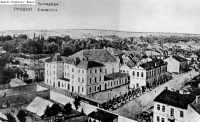 |
| Main Synagogue |
On 11 March 1943, tension in the ghetto rose to a fever pitch. The next day everyone was ordered into the synagogue. This time, though, the Jews did not believe Wiese’s assurances that they were being moved to Bialystok. Most were certain that their destination was Treblinka. Nevertheless, they remained quiet, careful not to antagonise their captors. The assembled Jews, 1,148 people, were force-marched from the synagogue to the train station and crammed into freight cars, about 110 to each car. When the train arrived at Bialystok, the railway cars were opened. The Jews were marched to the ghetto; only now did they believe that their destination was the Bialystok ghetto and not an extermination camp.
On 13 March 1943, posters were put up on the city’s streets announcing that Grodno was judenrein. On 14 July 1944, the Red Army liberated Grodno. Some forty to fifty Jews who had been in hiding in the city and its environs emerged. By the end of 1995, some 1,000 Jews remained in Grodno (out of a population of more than 250,000). Of them only five were former Grodno residents who survived the Holocaust, returned to their native town, and chose to remain.
Given the circumstances, there was a high level of resistance in the Bialystok district. Groups of partisans, both Jewish and non-Jewish, were active throughout the region. But one desperate act of resistance by Jews from Grodno is particularly noteworthy.
One evening in the second week of December 1942, a transport of about 2,000 Jews was brought to Treblinka from Kielbasin and included people from Grodno and the surrounding area. When the transport entered the camp, most of the prisoners had already been locked in their barracks. The deportees were brought to the transport yard and were ordered to undress and go to the "baths" / "showers". Some obeyed the order and were taken through the "tube" to the gas chambers. Amongst the last who remained in the transport yard and who had not yet undressed were a few dozen youths. They quickly realised the truth about where they were and the purpose Treblinka served. Some of them began calling out not to listen to the Germans and not to undress. A great riot broke out.
The Germans opened fire on the crowd. Suddenly there was an explosion. One of the young Jews had hidden a grenade and had thrown it in the direction of the shooting. Dozens of youths who were still in the transport yard began beating the Ukrainians and Germans with their fists and tried to break through the fences and escape. Other people from the transport joined them, and many dispersed throughout the various sections of the camp. Some succeeded in breaking through into the living barracks of the Jewish prisoners and sought cover. The Germans and Ukrainians recaptured them and returned them to the extermination area. The rest of the escapees were also caught throughout the camp. Dozens were shot on the spot as they resisted capture. At the entrance to the gas chambers the people continued to resist and absolutely refused to enter. The Germans and Ukrainians shot into the corridor where the victims had gathered. Many were killed and the rest finally forcibly pushed into the gas chambers. The Germans had learned a valuable lesson from this mass resistance incident, for subsequent transports to Treblinka were not received after dark.
Of the four major war criminals who were involved in the annihilation of the Jews of Grodno and its surroundings - Heinz Errelis, Kurt Wiese, Otto Streblow, and Karl Rinzler - the first two were brought to trial. Errelis’s deputy, Schott, killed himself after the war. Streblow was apparently killed in action, and Rinzler, the sadistic commandant of Kielbasin camp, disappeared. In 1966-1967, Wiese was tried in Bielefeld, Germany, together with Errelis and other Gestapo personnel who had been active in the Bialystok area. The court acquitted Errelis of charges of direct involvement in murder for lack of evidence. He was found guilty only of complicity in the murder of the Jews of Grodno in Ghetto I and of the Jews in the Bialystok ghetto, to which he was posted following the liquidation of the Grodno ghettos.
The sentences were handed down in April 1967. Errelis received six and a half years in prison and was deprived of German citizenship for five years. Wiese was convicted of murder and complicity in murder and received seven consecutive life terms.
In 1968, the two were also tried in Cologne, together with other war criminals who had been active in Grodno.
Sources:
Edited from Lost Jewish Worlds: The Communities of Grodno, Lida, Olkieniki, Vishay, published by Yad Vashem. See: www.grodnoonline.com
Sir Martin Gilbert: Atlas of The Holocaust
Yitzhak Arad: Belzec, Sobibor, Treblinka
Judgement in the Cologne trial of Wiese and Errelis.
Photos:
GFH
© ARC 2005